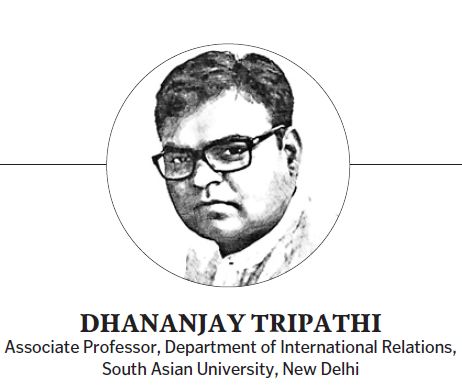Now that the US has exited Afghanistan and is determined to check the rise of China, Pakistan has lost its geopolitical appeal for its big donor
Published Date – 11:45 PM, Mon – 9 October 23

By Dhananjay Tripathi
Pakistan recently got into a severe economic crisis to the extent of being on the verge of default. For immediate economic survival, Pakistan secured a conditional loan from the International Monetary Fund (IMF), its 23rd bailout package in these many years. In July, the IMF agreed to give $3 billion to Pakistan after a prolonged negotiation. With this current loan, Pakistan got a lifeline, although true relief is a distant dream for the nation of some 240 million people.
Pakistan is among the top five borrowers of the IMF, which is worrying for any sovereign state. In this discussion, we cannot discount the prevailing political uncertainty and rise in terrorist activities in Pakistan. These will dampen the prospect of attracting foreign investment. Therefore, Pakistan may remain dependent primarily on its capacity to obtain more loans and aid in the future, and both are a daunting task. Pakistan is already under heavy debt, and geopolitically, it has lost its relevance for its principal donor.
Geopolitical (IR) Relevance
In the past, Pakistan easily received international support, mainly from the United States of America. Pakistan was the US’ Cold War ally. It emerged as a frontline state when the US decided to back the Afghan resistance against the invasion of the Soviet union in 1979.
As a neighbour of Afghanistan, Pakistan opened its border for Afghan refugees and gave military training to those Afghans who decided to fight the Soviets. The US wanted Afghanistan to be the Soviet’s Vietnam, so they poured money into Pakistan. According to the declassified reports, the US, after the Soviet invasion of Afghanistan, even overlooked Pakistan’s clandestine nuclear weapon programme.
Post-9/11 terrorist attacks, the geopolitical relevance of Pakistan once again brought US money to the country. This time, the US was determined to remove the Taliban from Afghanistan and for logistical reasons, Pakistan was preferred as an ally in the War Against Terror.
Pakistan officially sided with the US but never severed its ties with the Taliban. The US leaders at times expressed their frustration on the Taliban-Pakistan relations but failed to make any bold decisions due to the country’s geopolitical relevance. Thus, Pakistan kept drawing favourable amounts from the US without much hassle. In short, geography was advantageous to Pakistan, but more was needed to boost economic growth, prompting us to question the effectiveness of foreign aid.
Aid Effectiveness
Renowned Realist scholar Hans Morgenthau argued in a paper that foreign aid always has a political motive. He added that developing countries often fail to use aid constructively due to poor governance, orthodox social structures and rampant corruption. However, donors may prefer to overlook the mismanagement of funds if the purpose is to obtain political allegiance.
There was no scarcity of foreign funds for Pakistan, although it wasted enormous amounts of money on keeping an enmity with India. Pakistan possesses more than 150 nuclear weapons, and as per the Stockholm International Peace Research Institute (SIPRI) report in 2022, it had spent some $10 billion on defence, which is 0.5% of the world’s military spending. This kind of expenditure is questionable, particularly during the phase of economic hardship. Notably, Pakistan has an external public debt of more than $100 billion, which is huge for an economy of approximately $350 billion.
Pakistan was Asia’s highest aid recipient country from the 1960s to 1970s. According to a research article published in the Pakistan Development Review in 2007, Pakistan, from the 1960s to 2002, received some $73 billion in foreign aid. Pakistan also was amongst the largest recipients from the Coalition Support Fund (CSF) established by the US after the 9/11 terrorist attacks. Along with this help, under the Enhanced Partnership with Pakistan Act of 2009 (also known as the Kerry-Lugar-Berman Act), the US decided to give Pakistan approximately $7 billion in non-military aid for five years. While there were issues in between, and the US occasionally blocked the promised amount, the overall flow of money for Pakistan was high.
Now that the US has exited Afghanistan, is strategically involved in Europe, and is determined to check the rise of China so practically, Pakistan has lost its geopolitical appeal for its big donor. This implies that Pakistan has to explore other possibilities of economic survival.
Geoeconomics the Option?
Geoeconomics as an option was best articulated by ex-Pakistan Army Chief General Bajwa in 2021 at the Islamabad Security Dialogue. General Bajwa said, “it is important for us to embark upon a solid economic roadmap, backed up by infrastructural developments and regional integration”. General Bajwa indeed said that geoeconomics is the future of Pakistan. The point was well received outside Pakistan but started an intense debate inside. The disagreement was on the position of India. We witnessed a few Pakistani commentators criticising the army for going soft on India.
The anti-India politics in Pakistan has a formidable base, and there is opposition to mending relations with India. This defies economic rationality because, according to the World Bank estimates, India – and Pakistan can trade for more than $30 billion. In the changing world politics, Pakistan needs rethinking, and commercially engaging with the neighbouring economic powerhouse is a viable long-term solution. For Pakistan, the time is for ‘trade, not aid’. Let us hope that the next government of Pakistan moves in this direction; of course, any such proposition also requires some resonance in New Delhi.
While the last few years were bad for India-Pakistan relations, there are voices on both sides supporting the idea of trade for better ties.
Let us hope that there will be a new beginning of an economic partnership between the two neighbours.






